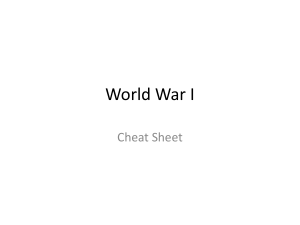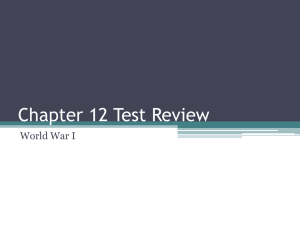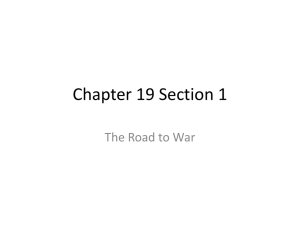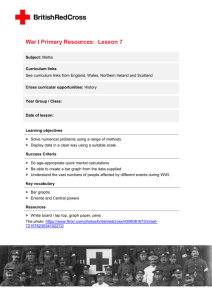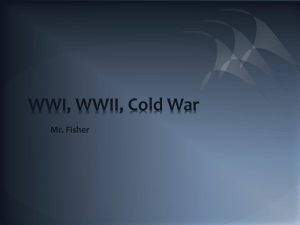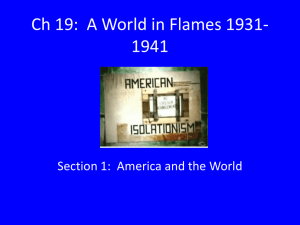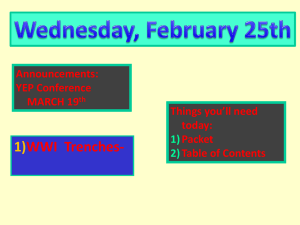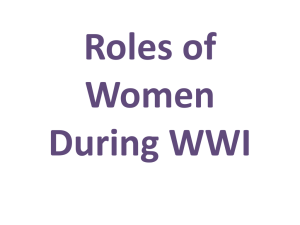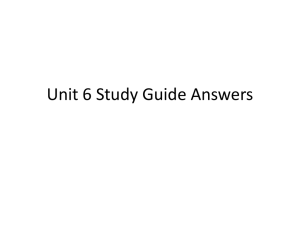Lesson 2: History - British Red Cross
advertisement
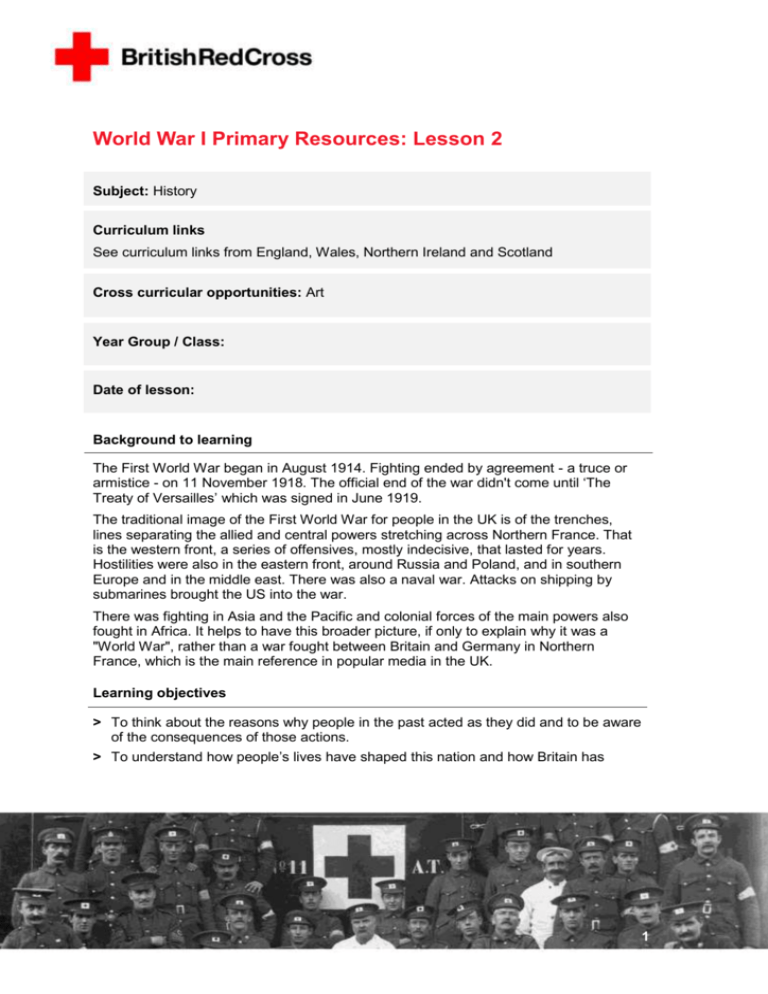
World War I Primary Resources: Lesson 2 Subject: History Curriculum links See curriculum links from England, Wales, Northern Ireland and Scotland Cross curricular opportunities: Art Year Group / Class: Date of lesson: Background to learning The First World War began in August 1914. Fighting ended by agreement - a truce or armistice - on 11 November 1918. The official end of the war didn't come until ‘The Treaty of Versailles’ which was signed in June 1919. The traditional image of the First World War for people in the UK is of the trenches, lines separating the allied and central powers stretching across Northern France. That is the western front, a series of offensives, mostly indecisive, that lasted for years. Hostilities were also in the eastern front, around Russia and Poland, and in southern Europe and in the middle east. There was also a naval war. Attacks on shipping by submarines brought the US into the war. There was fighting in Asia and the Pacific and colonial forces of the main powers also fought in Africa. It helps to have this broader picture, if only to explain why it was a "World War", rather than a war fought between Britain and Germany in Northern France, which is the main reference in popular media in the UK. Learning objectives > To think about the reasons why people in the past acted as they did and to be aware of the consequences of those actions. > To understand how people’s lives have shaped this nation and how Britain has 1 influenced and been influenced by the wider world. > To compare and contrast a society in the past with our own and contribute to a discussion of the similarities and differences. Success Criteria > To begin to understand who was involved in World War I and why we call it a ‘World War’. > To be able to describe how prosthetics developed during WWI, and how that might influence our lives today. Key vocabulary > Armistice Day > Western front > Allies > Ottoman Empire > Entente Powers > Central Powers > Prosthetics Resources > White board / lap top > Operation Ouch film (section 18:33- 21:57) > Paper, crayons, post its and flip chart paper 2 SEQUENCE OF LESSON – (based on 40 minute lesson) Timings 10 minutes Introduction Ask pupils what they remember from the film shown in lesson 1. Explore Ask pupils to write down on a ‘post it’ one thing they know about WWI and one thing they want to find out about it. Place on flip chart paper. Look at the maps of the Western front and the map of Europe in WWI and see where the main battles took place. Map of Western front http://www.greatwar.co.uk/places/ww1-western-front.htm#mapwesternfront Map of Europe WWI http://www.mapsofworld.com/world-maps/world-war-i-map-of-europe.html Now think of some words that seem to sum up how we see WWI. Examples Trenches, Mud, Football, Shooting, Battle of the Somme, Enemy, Bombs, Long way from home, Afraid, With friends… 25 minutes Group or class activities One of the major consequences of WWI was the terrible injuries sustained by the soldiers. This was the first time that powerful weapons and machinery were used and this resulted in a high number of amputees. 41,000 soldiers lost an arm or leg from the fighting – they wanted to work and look after their families so the UK Military Technicians came up with a solution and started making artificial limbs known as prosthetics. Watch the Operation Ouch film, section 18:33- 21:57, which shows how the making of prosthetics has changed in the last 100 years. Sophie Kamlish had her right leg amputated when she was aged nine and she went onto become a Paralympian competing in both the 100m and 200m events using a modern carbon fibre leg. Prosthetics transformed the lives of thousands of soldiers after the war and 3 are still helping people today. Ask pupils to think about what it might have been like to lose a limb in WWI. What wouldn’t they be able to do that they can now? What might they say to someone who had lost a limb? How would they support them? Now think what it must have been like in WWI if you were a soldier who had been injured. They may have been a long way from home, in hospital, with their family and some friends still at home. The only contact they would have had was through sending and receiving letters. On Platform 1 of Paddington station in London there is a statue of a WWI soldier who is reading a letter. People have been encouraged to think about what they might have wanted to say to the soldier 100 years ago and then write the letter he is reading. Have a look at some of the letters here: http://www.bbc.co.uk/schools/0/ww1/27110879 Now write a letter to a soldier who has been injured in WWI. Decide what injury he might have and how you might be able to help him. Think about who you are going to be – are you a son, daughter, sister, brother, parent or friend. What nationality is the soldier going to be, what nationality are you going to be? What could you say in a letter to make him feel better? Would you try and take his mind off his injuries by telling him what is going on at home, would it be a positive letter looking forward to when he comes home? Time available Plenary > Look at some of the questions on the post its. Put them on the flip chart and talk about them. (The post its can be used throughout the series of lessons and followed up finally in Lesson 8 Art.) > Read out some of the letters. > Ask the pupils if they have any letters at home that were written to their family in WWI that they can bring in to show the class. 4 Opportunities for Assessment Differentiation > Speaking & Listening > Task > Observations > Outcome > Questioning Evaluation What worked really well in my lesson? What do I want to focus on to improve future lessons? 5
